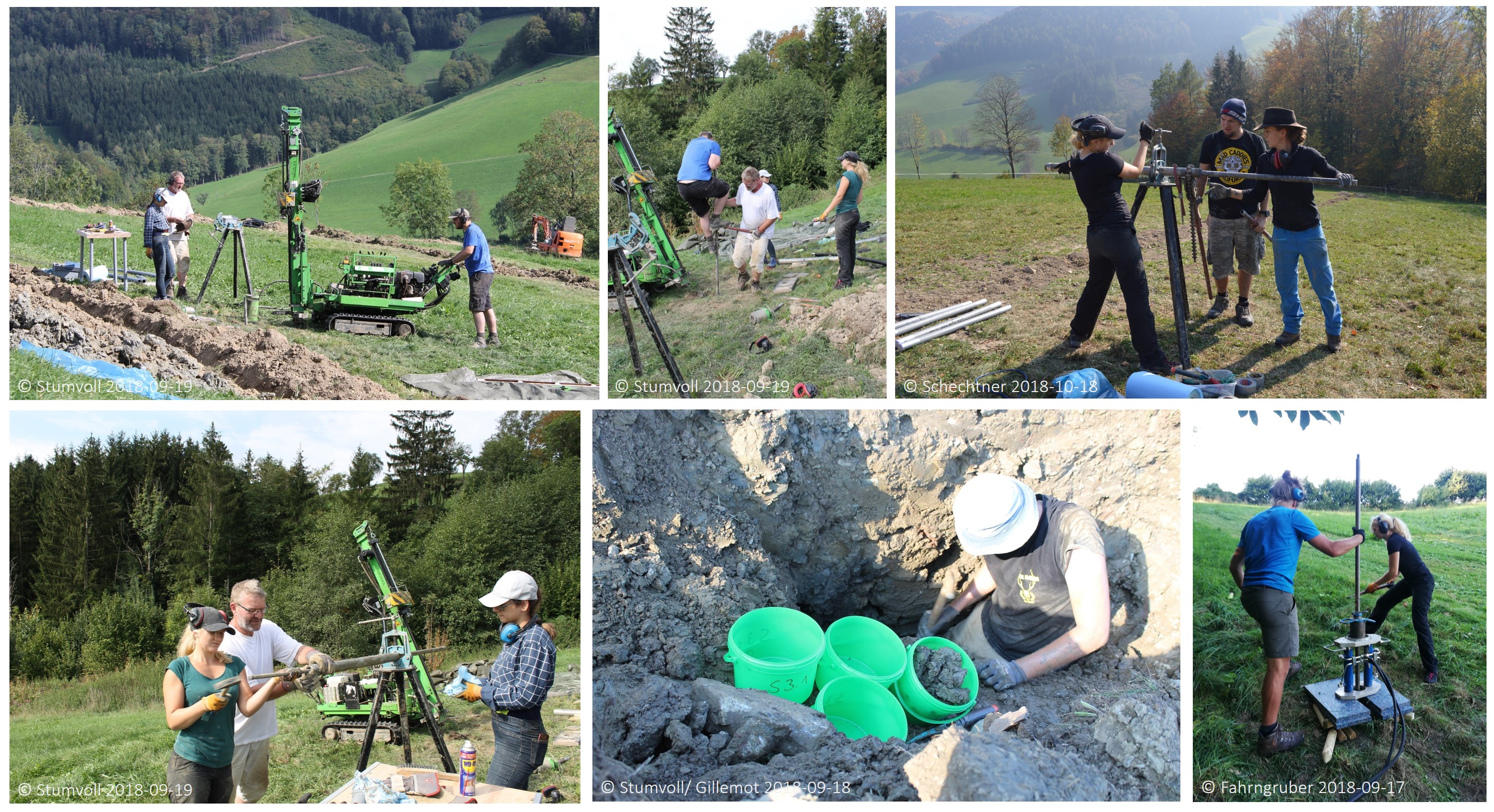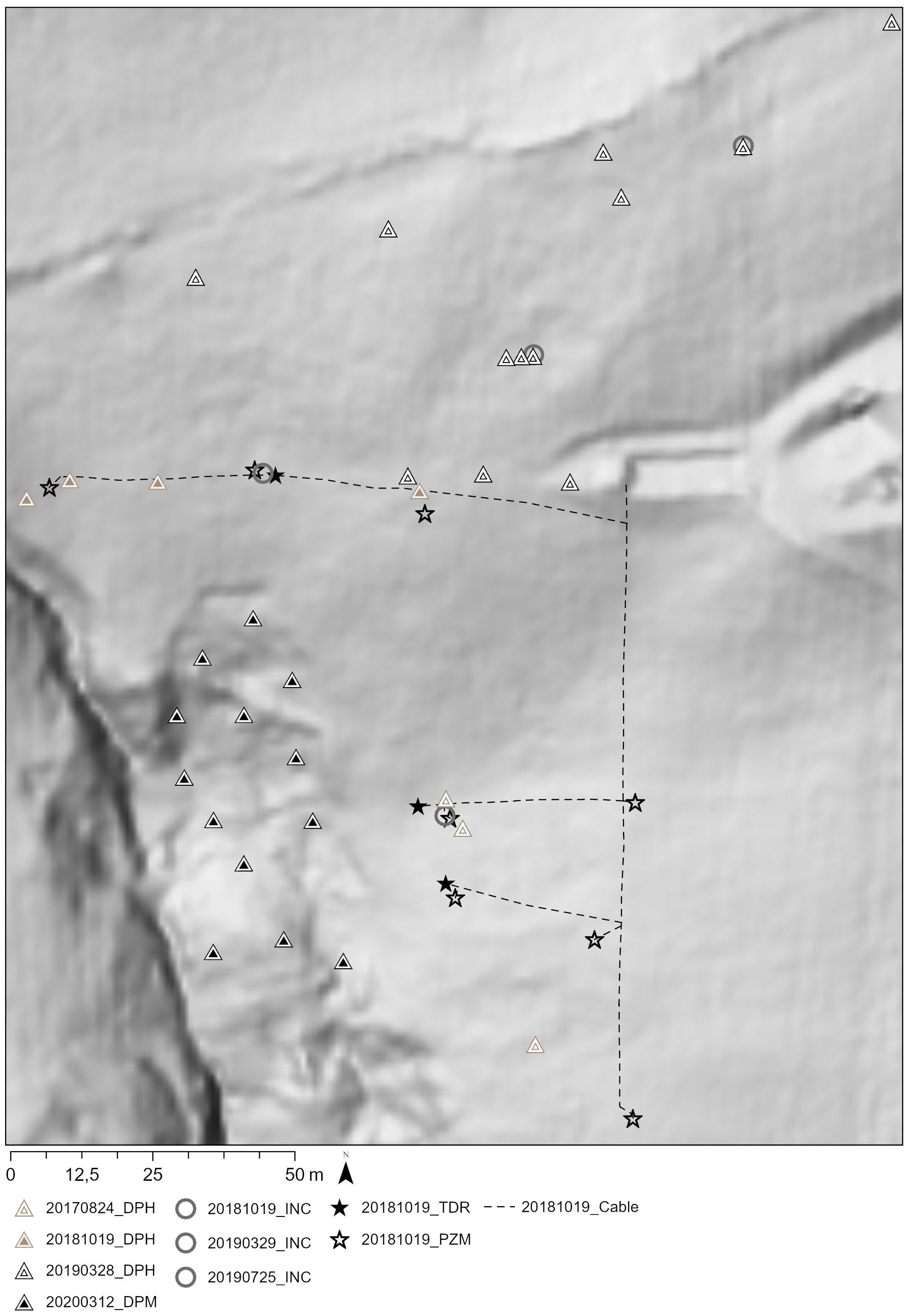Various methods of subsurface investigation are applied at the Hofermühle. In addition to direct methods (percussion drilling, drill core extraction and analysis / dynamic probing as well as installations for analyzing slope hydrology and movement), indirect methods (ERT/ electromagnetic induction/ Seismic) were applied in cooperation with the Vienna University of Technology (Ass.-Prof. Dr. Adrian Flores-Orozco and team).
In summary, the direct subsurface investigations include 10 drill cores and 3 pits (07.2016 / 09.,10.2018 / 03.2019 / (03.2020)) as well as a total of 32 Dynamic Probing Heavy (DPH) measurements. Data was taken at different dates (07.2016 / 09.,10.2018 / 03.2019, 03.2020) within the framework of the project, the final theses embedded therein and a project-related course.
At the moment the following sensors are permanently installed (Figure 6):
- 9 TDR probes at 3 locations (each at 0.5, 1 and 2 m depth; soil water content in [%])
- 8 piezometers (depth between 4 m and 6 m; height of the water column in [m])
- 1 automatic inclinometer (8 m)
- 4 manual inclinometers (~ 5 m (autumn 2018); ~ 6 m (03.2019); ~ 7 m (07.2019); ~6.5m (03.2021))
|
Figure 6: Subsurface installations at the Hofermühle site (Dynamic Probing Heavy (DPH), piezometer (PZM), TDR probes, inclinometer (INC)). (DEM (1m) 2009: made available by the Federal State Government of Lower Austria). Graphics: Stumvoll M.J. 2020. |
Inclinometer
Inclinometer measurements provide information about dynamics in the subsurface. Depending on the depth of the installation, it is e.g. possible to define one or more sliding planes /shear zones for an active landslide. There are currently 5 boreholes in the Hofermühle which are used for inclinometer measurements. 4 of them are measured approximately once each month using a manual inclinometer probe, one contains a permanently installed automatic chain inclinometer (measuring interval 5 min); these measurements are transmitted directly to a server in Vienna via the internet.

Figure 7: Impressions of the field work at the Hofermühle site. left) Installation of the automatic chain inclinometer, September 2018; middle) Piping of a manual inclinometer, October 2018; right) Readout of a manual inclinometer, March 2019. © Photographs see individual notes.
Piezometers and TDR probes
To examine the groundwater level and its changes, 8 piezometers are distributed over the upper slope (see Figure 6). In order to obtain additional information about the soil moisture at different depths, a total of 9 TDR probes are installed at 3 locations at 3 different depths each (0.5, 1 and 2m). Both piezometer and TDR data are recorded in a measuring interval of 5 minutes. Just like the inclinometer data, it is also sent directly to the server in Vienna and can also be accessed in almost real-time (Monitoring).

Figure 8: Impressions of the field work at the Hofermühle site, autumn 2018. left and left middle) Installation of piezometer teaching tubes; right middle and right) Installation of TDR probes. © Photographs see individual notes.
Dynamic Porbings (DPH), percussion drilling, drill core extraction and laboratory analyses
A total of 32 DPH profiles have been generated at the site since 2018. Their analysis is part of ongoing work. The drill cores (10) and direct soil samples (3 locations) taken at the site were or will be analyzed and evaluated as part of various final theses. Corresponding results are in progress.

Figure 9: Impressions of the field work at the Hofermühle site, autumn 2018. top and bottom left) Drilling core soundings and drilling core withdrawals; bottom middle) direct soil sampling (undisturbed samples) and bottom right) ram sounding (DPH). © Photographs see individual notes.
